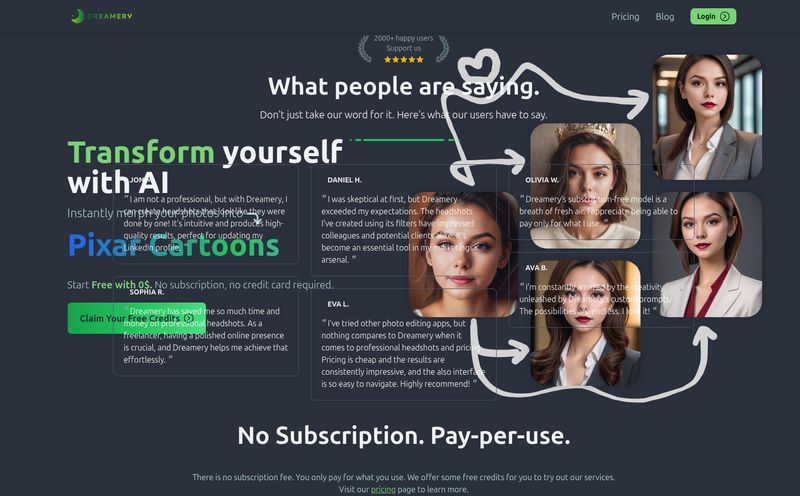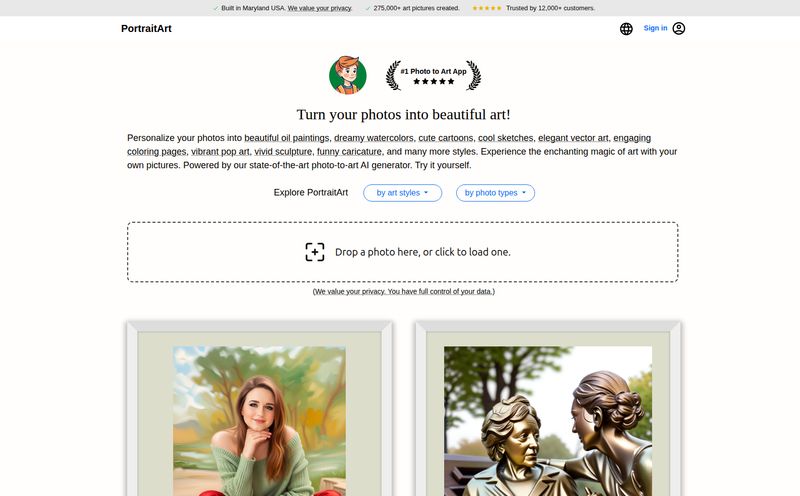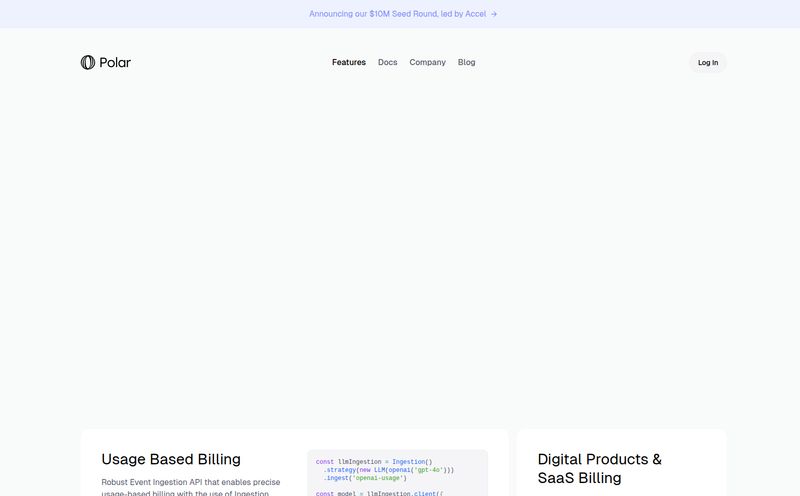I have a confession to make. My phone's camera roll is a digital junk drawer. It's a chaotic mix of blurry concert photos, screenshots of recipes I'll never cook, and about a thousand pictures of my dog from slightly different angles. But the other day, staring at a particularly dramatic photo of a storm cloud over my neighborhood, I had a thought: "That kind of looks like a Turner painting."
Of course, it was just a passing thought. Who has the time to actually cross-reference their random photos with centuries of art history? Well, it turns out an AI does. That’s when I stumbled upon a nifty little platform called artifiq. The premise is simple, almost comically so: you feed it one of your photos, and it tells you which famous artwork is its spiritual twin.
My inner art history nerd and my tech-loving SEO brain both perked up. An AI that plays art critic with your camera roll? I was equal parts skeptical and intrigued. I had to see this for myself.
What Exactly is This artifiq Thing?
Think of it like Shazam, but for your eyes. Instead of identifying a song playing in a noisy bar, artifiq analyzes the pixels of your photo—the colors, the shapes, the composition, the general vibe—and sifts through a massive digital museum to find its match. It’s a bit like a reverse image search that went to art school and developed a taste for oil on canvas.
It's not just looking for a photo of a dog to match a painting of a dog. No, it’s much more clever than that. The AI is designed to understand the underlying artistic elements. Does your selfie have dramatic lighting from one side? It might see a connection to a Rembrandt portrait, famous for its use of chiaroscuro. Did you snap a pic of a stark, minimalist cityscape? You might get matched with a Mondrian.
The goal is to forge a connection, to show you the art that hides in your everyday life. A pretty neat idea, if it works.

Visit artifiq
I Put It to the Test: My artifiq Experience
So, with a healthy dose of skepticism, I dove in. I decided to give it three distinct challenges from my digital junk drawer.
- The Moody Selfie: Taken on a Monday morning. Poor lighting, questionable hair. The whole nine yards.
- The Dog Photo: My scruffy terrier mix, mid-yawn, looking utterly chaotic.
- The Backyard Landscape: A simple shot of my slightly overgrown garden at sunset.
The process was dead simple. Upload, wait a few seconds, and bam. The results were… fascinating. My moody selfie, to my astonishment, was paired with a 17th-century Dutch portrait. The AI pointed out the similar soft lighting and somber expression. I wouldn't say I looked like a noblewoman, but I suddenly felt a little more profound. My bad hair day had historical significance.
The dog yawn? It was matched with a dynamic, almost violent piece of abstract expressionism. At first, I laughed. Then I looked closer. The explosion of color, the sense of unbridled energy… yeah, I could see it. It was a stretch, but a fun one. The AI wasn't just matching subjects, it was matching feeling. My backyard photo was paired with a serene Impressionist landscape, and that one was almost spookily accurate, right down to the color palette of the fading sun. I was impressed.
More Than Just a Fun Gimmick
What started as a fun five-minute distraction quickly revealed itself to be something more. This wasn’t just a social media toy; there's a real substance under the hood.
A Crash Course in Art History
Here’s the part that really won me over. artifiq doesn’t just show you the painting. It gives you a little pop-up lesson. You get the name of the artwork, the artist, the year it was made, and a brief description of the piece and its context. It's like having a museum curator pop out of your phone.
Suddenly, I wasn’t just looking at a pretty picture; I was learning about the Baroque period and why artists were so obsessed with dramatic light. It turned a silly experiment into an impromptu, bite-sized educational moment. It reminded me of those late nights you fall down a Wikipedia rabbit hole, but way more visually engaging.
Seeing Your Own Photos Differently
The other, unexpected side effect? It made me look at my own photos with a new eye. That random shot of rain on a window wasn't just a wet window anymore; it was a study in texture and reflection. The way I’d framed a picture of my coffee cup suddenly had compositional weight. It’s a fantastic tool for any content creator, photographer, or anyone who just wants to get a little better at taking interesting pictures. It teaches you to see the art in the ordinary, which is a skill I think we could all use more of.
Let's Talk Brass Tacks: The Good and The Not-So-Good
Alright, no tool is perfect. As much as I enjoyed my trip through art history, let's get down to the nitty-gritty. What I really loved was the sheer simplicity and speed. In an age of clunky software and endless sign-up forms, the instant gratification of artifiq is a breath of fresh air. The educational component is its true secret weapon.
But let's have a reality check. The AI, for all its cleverness, is still a machine trying to interpret art, one of the most subjective human creations. Some matches will feel profound, others will feel like a bit of a random guess. You have to go into it with a sense of playfulness. Don't expect it to find a literal 1-to-1 copy of your face in a Renaissance painting.
The biggest catch is the limit on free matches. You get a few to whet your appetite, which is fair, but then you're cut off. As for the cost of more matches? I have to be honest, I couldn't find a clear pricing page on their site. This is a bit of a pet peeve of mine; transparency in pricing is always best. It leaves you wondering if it's a subscription, a per-match fee, or something else. Hopefully, they make that clearer soon.
Who is artifiq Actually For?
So, who should be rushing to try this? I can see a few groups getting a real kick out of it.
- Art Students & Enthusiasts: It’s a brilliant way to discover new artists and movements in a context that’s personal to you.
- Social Media Mavens: The content potential is huge. Imagine the Instagram carousels: "My Dog as Famous Artworks." It's unique, it's funny, and it's smart.
- Teachers and Educators: What a fantastic hook to get students engaged in an art history lesson! "Let's see what artist your selfie looks like, and then learn about them."
- The Curious: Honestly, if you're like me and just love fun, clever tech that makes you think a little differently, it’s ten minutes well spent.
My Final Take: Is It Worth Your Time?
Yes. Absolutely. Go try it. Even with the slightly wonky matches and the mysterious pricing, the core experience is just plain cool. It's a delightful intersection of technology and the humanities. It won't replace a trip to The Met or the Louvre, but it does something different—it brings the museum to you, framed by your own life.
In a world full of AI tools promising to optimize our workflow and make us hyper-productive, it's genuinely refreshing to find one that's just designed to spark a little joy and curiosity. It doesn't want to make you more efficient; it just wants you to see the world a little more artistically. And I think thats a masterpiece in itself.
Frequently Asked Questions about artifiq
- Is artifiq free to use?
- It's free to start! You get a few initial matches to try out the platform. After that, the model for getting more matches isn't super clear, but it appears to be a paid feature. It’s best to view the free version as a fantastic trial.
- How accurate is the AI art matching?
- It varies! Sometimes it's uncanny, especially with composition, color, and mood. Other times, it's more of a creative interpretation. Think of it less as a scientific facial recognition tool and more as an artistic pairing service. The fun is in seeing what it comes up with.
- What kind of photos work best with artifiq?
- Experiment! I found that photos with interesting light, clear compositions, or strong moods worked well. But half the fun is throwing random things at it. Portraits, landscapes, abstract shots of your shoelaces—give it all a try. The AI is looking for patterns you might not even see.
- Does artifiq store my photos?
- While I can't speak for them directly, most modern AI image tools process your photo on their servers to find the match and then discard it to protect user privacy. It’s always a good idea to check the platform's official privacy policy for the most accurate information before uploading personal images.
- Can I use artifiq for my social media content?
- Absolutely! It seems practically designed for it. Sharing your photo next to its artsy twin is a perfect recipe for an engaging and original post on Instagram, Twitter, or Facebook. Just be sure to credit the tool.
The Last Brushstroke
At the end of the day, artifiq is a reminder that art isn't just something that hangs in a stuffy gallery. It’s a language of light, color, and emotion that we all participate in, even when we're just snapping a quick picture of a sunset. Go find your art twin. You might be surprised at the masterpiece you discover.
Reference and Sources
For those interested in the intersection of AI and art, and to explore masterpieces on your own, here are some great resources:
- The Metropolitan Museum of Art's Open Access Collection: A fantastic resource for exploring high-resolution images of thousands of public-domain artworks.
- MIT Technology Review - How AI is helping art historians: An article discussing how machine learning is being used to analyze and understand art collections on a massive scale.



